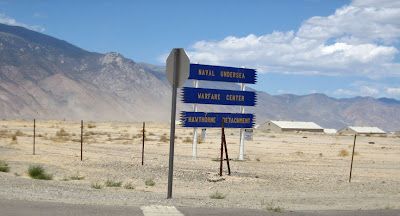 |
| Steam Vents in the Desert |
 |
| The sign says "Danger, Scalding Water" |
Promontory
Summit Utah – 66 miles north of Salt Lake City
On
May 10, 1869 the Union Pacific and Central Pacific Railroads joined
their rails at Promontory Summit, (not Promontory Point as I thought) Utah
Territory and forged the destiny of the nation.
The
Golden Spike National Historic Site shares this historic event
through displays in the visitor's center and reenactments. We were
able to catch one of the reenactments.
First
they bring out the trains:
The
Jupiter
The
Jupiter pulled
Central Pacific’s President, Leland Stanford’s, special train to
Promontory Summit, Utah Territory, for the Golden Spike Ceremony.
 |
| Replica - but as exact as possible |
The Jupiter Arrives
Engine
No. 119
Engine
No. 119 received
the call to pull Union Pacific Vice-
President Thomas Durant and his
contingent of dignitaries to Promontory Summit.
 |
| Engine 119 Arrives Again - a replica but as close to the original as possible |
Then
the reenactors give short speeches (as opposed to what the actual verbose oratory of the day would have been), and provide a feel for how the ceremony proceeded (if there had been a few hundred more people here)
 |
| Speech Making |
 |
| The engines nose to nose as they would have been in 1869 |
Then
it is time to drive The Ceremonial Spikes
4
of them – A golden spike from San Francisco contractor David Hewes,
friend of Leland Stanford; a silver spike from Nevada, a gold and
silver plated spike from Arizona Territory, a second golden spike
from Frederick Marriott, owner of the San Francisco News Letter.
None of these were actually “hit” but placed and tapped with a
ceremonial silver maul.
 |
| "Thomas Durant" tries to stay upright when driving the final spike. |
(The
first gold spike and the silver spike now reside at Stanford
University. The Arizona Spike is owned by the Museum of the City of
New York. The location of the 4th spike is unknown - so check your attics)
After
the precious metal spikes were removed, an ordinary pine tie was
placed to be driven with normal iron spikes. Leland Stanford took a
mighty swing at the final spike and struck the tie instead. Durant,
not feeling well (drunk) swung and missed even the tie. Finally a
regular railroad worker drove the last spike and the Western Union
telegraph operator sent the message D-O-N-E.
The
building of the transcontinental railroad is a fascinating story and
if you would like to learn more I highly recommend: Nothing Like it
in the World: The Men Who Built the Transcontinental Railroad
1863-1869 by Stephen E. Ambrose and to follow that Rival Rails: The
Race to Build America's Greatest Transcontinental Railroad by Walter
R. Borneman.
It
is my hope that someone reading these blogs will be inspired to learn
more about United States history!
We
also recommend visiting this national historic site and witnessing
the reenactment.















































